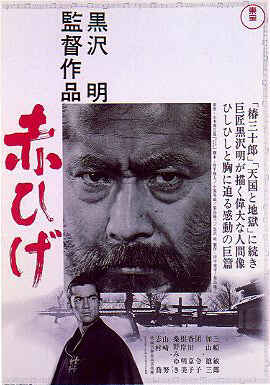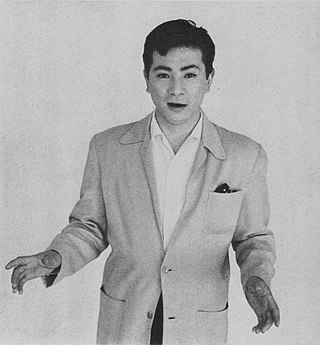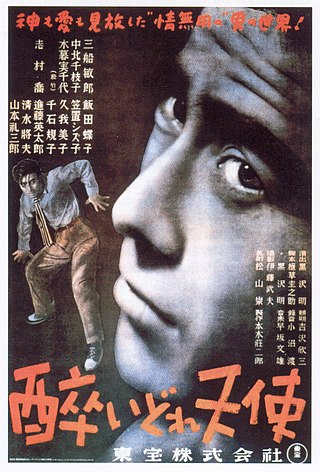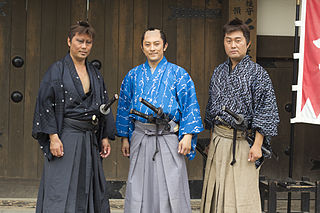Related Research Articles

Akira Kurosawa was a Japanese filmmaker who directed 30 films in a career spanning over five decades. He is widely regarded as one of the greatest and most influential filmmakers in the history of cinema. Kurosawa displayed a bold, dynamic style, strongly influenced by Western cinema yet distinct from it; he was involved with all aspects of film production.

Seven Samurai is a 1954 Japanese epic samurai action film directed by Akira Kurosawa from a screenplay co-written with Shinobu Hashimoto and Hideo Oguni. Taking place in 1586 in the Sengoku period of Japanese history, it follows the story of a village of desperate farmers who seek to hire samurai to combat bandits who will return after the harvest to steal their crops.

Throne of Blood is a 1957 Japanese jidaigeki film co-written, produced, edited, and directed by Akira Kurosawa, with special effects by Eiji Tsuburaya. The film transposes the plot of English dramatist William Shakespeare's play Macbeth (1606) from Medieval Scotland to feudal Japan, with stylistic elements drawn from Noh drama. The film stars Toshiro Mifune and Isuzu Yamada in the lead roles, modelled on the characters Macbeth and Lady Macbeth.

Rashomon is a 1950 Japanese jidaigeki film directed by Akira Kurosawa from a screenplay he co-wrote with Shinobu Hashimoto. Starring Toshiro Mifune, Machiko Kyō, Masayuki Mori, and Takashi Shimura, it follows various people who describe how a samurai was murdered in a forest. The plot and characters are based upon Ryūnosuke Akutagawa's short story "In a Grove", with the title and framing story taken from Akutagawa's "Rashōmon". Every element is largely identical, from the murdered samurai speaking through a Shinto psychic to the bandit in the forest, the monk, the assault of the wife, and the dishonest retelling of the events in which everyone shows their ideal self by lying.

Red Beard is a 1965 Japanese jidaigeki film co-written, edited, and directed by Akira Kurosawa, in his last collaboration with actor Toshiro Mifune. Based on Shūgorō Yamamoto's 1959 short story collection, Akahige Shinryōtan, the film takes place in Koishikawa, a district of Edo, towards the end of the Tokugawa period, and is about the relationship between a town doctor and his new trainee. Fyodor Dostoevsky's novel Humiliated and Insulted provided the source for a subplot about a young girl, Otoyo, who is rescued from a brothel.

Dreams is a 1990 magical realist anthology film of eight vignettes written and directed by Akira Kurosawa, starring Akira Terao, Martin Scorsese, Chishū Ryū, Mieko Harada and Mitsuko Baisho. It was inspired by actual recurring dreams that Kurosawa said he had repeatedly. It was his first film in 45 years in which he was the sole author of the screenplay. An international co-production of Japan and the United States, Dreams was made five years after Ran, with assistance from George Lucas and Steven Spielberg, and funded by Warner Bros. The film was screened out of competition at the 1990 Cannes Film Festival, and has consistently received positive reviews.

Ikiru is a 1952 Japanese tragedy film directed by Akira Kurosawa from a screenplay co-written with Shinobu Hashimoto and Hideo Oguni. The film examines the struggles of a terminally ill Tokyo bureaucrat and his final quest for meaning. The screenplay was partly inspired by Leo Tolstoy's 1886 novella The Death of Ivan Ilyich.

Shintaro Katsu was a Japanese actor, singer, and filmmaker. He is known for starring in the Akumyo series, the Hoodlum Soldier series, and the Zatoichi series.

Drunken Angel is a 1948 Japanese yakuza noir film directed and co-written by Akira Kurosawa. It is notable for being the first of sixteen film collaborations between director Kurosawa and actor Toshiro Mifune.
Dodes'ka-den is a 1970 Japanese drama film directed by Akira Kurosawa. The film stars Yoshitaka Zushi, Kin Sugai, Toshiyuki Tonomura, and Shinsuke Minami. It is based on Shūgorō Yamamoto's 1962 novel A City Without Seasons and is about a group of homeless people living in poverty on the outskirts of Tokyo.

Mono no aware (物の哀れ), lit. 'the pathos of things', and also translated as 'an empathy toward things', or 'a sensitivity to ephemera', is a Japanese idiom for the awareness of impermanence, or transience of things, and both a transient gentle sadness at their passing as well as a longer, deeper gentle sadness about this state being the reality of life.

The Idiot is a 1951 Japanese film directed by Akira Kurosawa from a screenplay co-written with Eijirō Hisaita. It is based on the 1869 novel The Idiot by Fyodor Dostoevsky. The original 265-minute version of the film, faithful to the novel, has been long lost. A nearly three-hour release, reflecting a 100-minute studio-imposed cut, currently survives as the most complete version of the film available for contemporary audiences.

Donald Richie was an American-born author who wrote about the Japanese people, the culture of Japan, and especially Japanese cinema. Although he considered himself primarily a film historian, Richie also directed a number of experimental films, the first when he was seventeen.

No Regrets for Our Youth is a 1946 Japanese film written and directed by Akira Kurosawa. It is based on the 1933 Takigawa incident, and is considered a quintessential "democratization film", taking up many themes associated with social policy under the early Occupation of Japan.

Chanbara (チャンバラ), also commonly spelled "chambara", meaning "sword fighting" films, denotes the Japanese film genre called samurai cinema in English and is roughly equivalent to Western and swashbuckler films. Chanbara is a sub-category of jidaigeki, which equates to period drama. Jidaigeki may refer to a story set in a historical period, though not necessarily dealing with a samurai character or depicting swordplay.
The films of Japanese director Akira Kurosawa have had a far-reaching impact on cinema and how it is produced, both within Japan and internationally. As a result of his influence, Kurosawa's work, as well as his personal character, have been subject to a number of negative criticisms. These criticisms are points of heated debate among those who study Kurosawa's work, and scores of pieces have been written both advocating for these criticisms and defending against them.
A list of books and essays about Akira Kurosawa:

The legacy of filmmaking technique left by Akira Kurosawa (1910–1998) for subsequent generations of filmmakers has been diverse and of international influence beyond his native Japan. The legacy of influence has ranged from working methods, influence on style, and selection and adaptation of themes in cinema. Kurosawa's working method was oriented toward extensive involvement with numerous aspects of film production. He was also an effective screenwriter who would work in close contact with his writers very early in the production cycle to ensure high quality in the scripts which would be used for his films.
The Warrior's Camera: The Cinema of Akira Kurosawa is a 1991 non-fiction book by Stephen Prince, published by Princeton University Press, discussing Akira Kurosawa's films from the beginning until 1985. Prior to the publication of this book, there was only one other scholarly book work, The Films of Akira Kurosawa, chronicling the whole collection of Kurosawa's works.
References
- Desser, David (1998). "The Films of Akira Kurosawa". The Journal of Asian Studies . 57 (4): 1172–1173. doi:10.2307/2659350. JSTOR 2659350.
- Vera, Jose M. de (1966). "The Films of Akira Kurosawa". Monumenta Nipponica . 21 (3/4): 433–436. doi:10.2307/2383398. JSTOR 2383398.